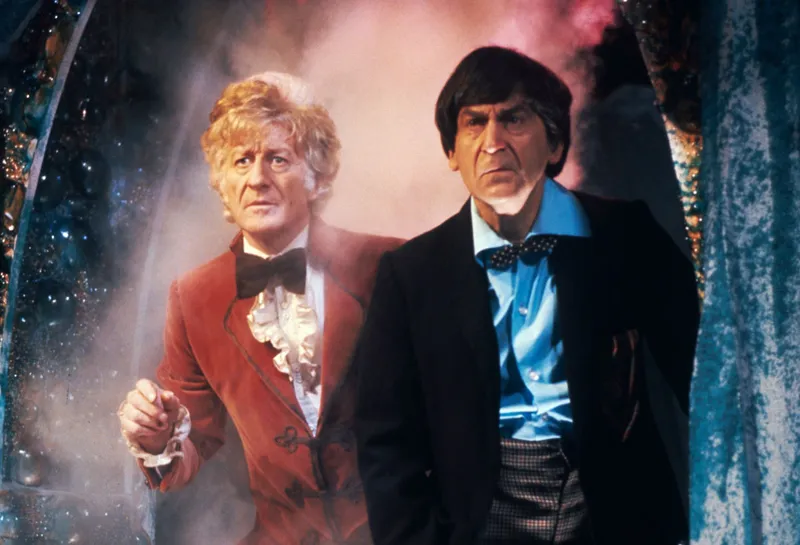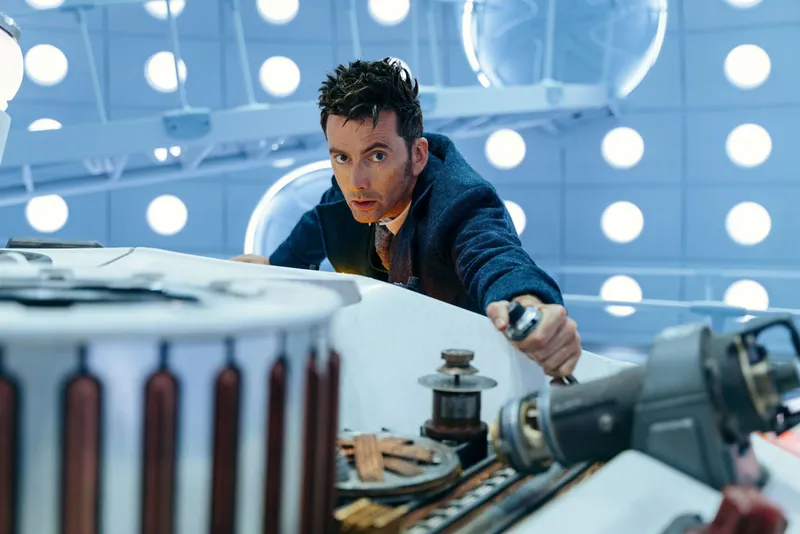At 60 years old, Doctor Who, the BBC Show following the adventures of the regenerating Time Lord, continues to be highly enjoyable fiction. But it’s science fiction. The Doctor’s primary tool is a sonic screwdriver, not a magic wand. The Gallifreyan takes science seriously. And so should we…
Why is the TARDIS really bigger on the inside?
One of the most immediate, and paradoxical, scientific puzzles raised by Doctor Who is the nature of the TARDIS, the Doctor’s vehicle, home and constant companion.
You know what comes next: ‘It’s bigger on the inside than the outside!’ (Or, as one episode’s smart alec put-down line had it, ‘It’s smaller on the outside!’). With the exterior of an antiquated British police telephone call box – the size of a large-ish wardrobe – it appears to contain at least the volume of a roomy house, if not more. Can this be plausible?
In fact, an imaginative extrapolation of Albert Einstein’s theory of relativity might permit the possibility that something being bigger-on-the-inside doesn’t have to be immediately ruled out – as well as that old police box’s main function, as a time machine. Because relativity is all about distortions of space and time. And as fans of Doctor Who know, TARDIS is an acronym for Time And Relative Dimension In Space.

Einstein’s great breakthroughs in physics, starting in the early decades of the 20th century, came from imaginative, even playful, dreaming of which the Doctor would probably approve. What, Einstein wondered, would the Universe look like if you tried to catch up to a beam of light by travelling on a very fast starship?
The problem is that the speed of light – around 300,000km per second – is determined by other laws of physics, specifically the laws of electromagnetism. And physics doesn’t care how fast you’re travelling as you measure that speed; those laws don’t change, no matter how fast you go. And so a given beam of light always has the same velocity relative to you – and to everybody else, no matter how they’re moving.
So, if Einstein measures the speed of a given beam of light relative to his starship in flight, and a colleague back on Earth measures the speed of that same beam of light relative to their own, apparently stationary laboratory, the two would get precisely the same answer – regardless of how fast Einstein was travelling.
From this apparent paradox, Einstein built his Special Theory of Relativity. Essentially, space and time bend to ensure that observers moving relative to each other, always measure the same speed of light. In particular, as seen from Earth, the accelerating Einstein clock will seem to run slower than those on Earth.
But relativity goes beyond contradictory clocks. Later, Einstein incorporated gravity into his theory (this extended version became known as the General Theory of Relativity) and was able to predict the ‘bending’ of space-time that maintains the constancy of light speed. This bending was tested in Einstein’s day by studying the deflection of starlight by the Sun’s gravity, and in recent times by studies of Sagittarius A*, the huge black hole at the centre of the Milky Way.
Read more:
- Doctor Who: Could regeneration really be possible?
- Evil doppelgängers, alternate timelines and infinite possibilities: the physics of the multiverse explained
After more huge conceptual leaps, Einstein’s General Theory of Relativity became the essential support for the Big Bang theory, our best model of how the Universe was born and evolves. Not bad for an imaginary ride on a light beam.
All this may seem exotic, but its relevance to the TARDIS is that we all live out our lives in bent space-times. For example, the Sun’s mass creates a gravity well with the planets skimming around its ‘walls’ – their velocity balancing the gravity, not unlike the rolling of the ball in a roulette wheel.
Now, we don’t know how Time Lord engineers folded a house into a phone box, but once we know that space-time can be bent and folded and distorted, it takes only a little imagination (or a lot) to put those concepts together.
If you’re still unconvinced, consider this. According to the theory behind the Big Bang, the Universe, in its earliest moments, was smaller than a subatomic particle. It could have fitted inside a regular police box – let alone the Doctor’s roomy chambers.
Is time travel real? (And is it actually timey-wimey?)
Even with Special Relativity, disturbing time slippages can occur. Consider again the thought experiment of the observers on a spacecraft and Earth. This time, put Einstein on a starship accelerating at one Earth gravity (9.8 metres per second squared).
Einstein, given enough fuel and supplies, could go as far as he liked. And, as we know, to ensure his light-speed measurement is unchanged, his clocks will slow throughout the journey, compared to clocks on Earth.
Carry on accelerating at one gravity for 13 subjective years, and Einstein would arrive 1,000 years into the future relative to the observer on Earth (and about 1,000 light-years from home). Suddenly we have a time machine – to the future, at least.

But what about travel to the past? And how could Einstein get home? As it happens, Einstein may also have found the solution to this conundrum in work he started in 1916.
He had been studying a relativistic mathematical model of a star – or any spherical, uncharged, massive object – developed by a German mathematician called Karl Schwarzschild. The equations described the gravitational field at a positive distance from the massive object’s centre. But Einstein noticed that the equations also worked if you fed in a negative distance. What could this mean, physically?
The physicists eventually realised that space-time could be ‘bent’ on a large scale, bringing two of these massive objects together to make a ‘bridge’ that would enable travellers to take shortcuts through space.
By the 1950s, these bridges had been labelled ‘wormholes’ by American physicist John Wheeler, and the theory behind them has been studied intensely in the years since. Over the same period, wormholes have become a staple of science fiction and what’s important for our purposes is that they offer us one way to build a two-way time machine.
Recall Einstein’s long trip. An observer on Earth, armed with a powerful telescope, would see the ship taking 1,000 years to reach its destination. The time Einstein would measure, with clocks aboard his ship, would be 13 years.
Now suppose Einstein carried one end of a wormhole with him, leaving the other end on Earth. When he reaches his destination, he can simply step through it and emerge back on Earth. Einstein’s clock says he’s 13 years older; but Earth is 1,000 years older. So Einstein has travelled into his future.
Similarly, someone on Earth could pass through the wormhole Einstein appeared from and travel nearly 1,000 years into their past (and emerge aboard a spaceship 1,000 light-years away).
You could imagine a Universe full of wormhole mouths, connecting points across space-time, future and past. A fixed network like this might seem far behind the capabilities of the TARDIS, which can take you anywhere and any when, just as a car gives you a level of freedom the London Underground can’t.
Maybe the Time Lords have an altogether more efficient way of doing things. But, as the Doctor might say, what isn’t ruled out by the laws of physics is just a question of engineering.
Just how smart is the TARDIS AI?
Another aspect of TARDIS technology is its controlling artificial intelligence (AI). We know the TARDIS is super-smart and even capable of empathy, it seems (it certainly has a tight bond with the Doctor). But what kind of technology might support such processing?
Perhaps the TARDIS, a vehicle navigating highly abstract mathematical spaces, might run on highly abstract mathematical mechanisms. But what kind of mechanisms?
For an up-to-date suggestion, consider the ‘three-body problem’. This is a gravitational conundrum that’s more than 300 years old, and this year researchers working in Bulgaria discovered more than 12,000 solutions to it.

In Isaac Newton’s mathematics, the shared orbit of two bodies is well understood. If one is much larger than the other, as the Sun is larger than Earth, both bodies orbit around a point deep inside the more massive body. If the bodies are of similar sizes, they can both orbit around a shared point in empty space, called a ‘barycentre’.
But it becomes more complicated when three bodies are involved. Only about 600 solutions were known until 2017, when about 600 more solutions were found. Now, in 2023, a supercomputer has delivered a whopping 12,392 solutions. And there seems no reason why solutions involving many more bodies can’t be found.
These solutions would be magical to watch, as the three bodies loop and dive around each other – and when each ‘orbital routine’ is finished, it repeats indefinitely. These results have obvious applications for astronomers studying complex stellar and planetary systems.
But for our purposes, perhaps these patterns and their more complicated siblings, could also encode a great deal of information in a dynamic, precise mathematical form. Could an array, even a hierarchy, of co-orbiting clusters of n-body solutions store enough data to encode the AI of a TARDIS? Much like the idea of storing data in flocks of starlings in flight…
It may be wrong, but I’d bet the true engineering of the TARDIS would be just as beautiful.
Read more:
- Instant Genius Podcast: Time travel, with Lawrence Krauss
- Doctor Who: Could aliens really wipe your memory?
Is Earth about to be invaded by aliens?
The Earth of Doctor Who has suffered multiple alien invasions.
The earliest (in the show’s history), as depicted in the serial ‘City of Death’ in 1979, was by a warrior race called the Jagaroth 400,000,000 years ago. A survivor called Scaroth left fragments that deflected the history of Earth and humanity from then on. So, in the Who universe, an engagement with the alien has been woven into our evolution.

A clumsier, but just as devastating, intervention occurred 65 million years ago when, according to the serial ‘Earthshock’ in 1982, a massive interstellar freighter travelled back in time and crashed to Earth – an impact that wiped out the dinosaurs, as opposed to a rogue asteroid strike as scientists would have it. We can even guess at the dimensions of the freighter given a (real-world) study of the dinosaur event.
The asteroid, which hit with the energy of 4.5 billion Hiroshima bombs, must have been roughly the size and mass of Mount Everest. But a mass of 1,000 tonnes of antimatter would deliver the same bang – a mass that could propel a 1,000-tonne freighter to Alpha Centauri at close to the speed of light.
We may have seen an alien vessel, or the wreckage of one, wandering through our Solar System in recent years – the anomalous ‘Oumuamua object. Its high velocity proved it came from outside the Solar System and its long, thin shape was highly unusual.
Probably it was nothing more than an exotic asteroid fragment, but if it had struck Earth… well, it was no ‘Earthshock’ freighter. At an estimated mass of 40 tonnes and travelling at 40 metres per second, ‘Oumuamua would have burned up in Earth’s atmosphere.
Are rogue planets actually hidden throughout our galaxy?
Doctor Who is entertainment, but it has scored some predictive hits concerning the advance of scientific knowledge over the decades. For example, it has long been a peculiarity of the show to feature rogue planets in our Solar System.
When the show first aired in 1963, it was believed that there were nine planets in the Solar System, with the furthest out, Pluto, discovered only a few decades before. And it was believed that these planets had emerged from a reasonably logical and orderly formation process.
You had the rocky worlds closest to the Sun: Mercury, Venus, Earth and Mars. Further out, where temperatures were lower and the planets could retain huge volumes of gases and ices, you had the gas giants (Jupiter and Saturn) and the ice giants (Uranus and Neptune), with Pluto at the edge of the system.

So scientific eyebrows would have been raised by ‘The Tenth Planet’, the first Cyberman story, broadcast in 1966 and set in 1986. This featured Mondas, a rogue planet on the edge of the known Solar System. This, and the Cybermen, were a threat to Earth, but eventually the planet apparently left the system under its own power.
Then came Vulcan, in ‘The Power of the Daleks’, also broadcast in 1966: a planet inside the orbit of Mercury, which also disappeared, in this case in the show’s year 2020. (Early astronomers had hypothesised the existence of a Vulcan, but this turned out to be caused by misread sightings of Mercury.)
And then there was Voga in ‘Revenge of the Cybermen’, broadcast in 1975 – a world made entirely of gold. This planet had wandered into the Solar System and become a satellite of Jupiter. By the year 2875 it had become a target for human miners.
Such exotic and wandering planets didn’t fit into the orderly Solar System models that were current in 1963, and perhaps added to the show’s sense of implausible fun. But time, deeper observations and more mature theoretical modelling have changed our view of the origin of the planets. And now we know that the Solar System itself has a more complex history than once believed.
Just three years after ‘The Tenth Planet’ was broadcast, for example, with attention focused on the Moon due to the Apollo missions, the Big Splash theory of the Moon’s origin was developed. During the formation of Earth, another protoplanet with the mass of Mars (called Theia) crashed into Earth, causing huge ejections of rock that eventually coalesced into the Moon.
Later, in 1992 (14 years before our perceived outermost planet was controversially downgraded to dwarf planet status), came the discovery that Pluto isn’t the limit of the Solar System. Beyond it – between 30-40 times Earth’s distance from the Sun – lies the Kuiper belt, a swarm of objects made of rock and ices, with over 100,000 so far detected that are over 100km (60 miles) in diameter. Among that swarm are five ‘dwarf planets’ on looping orbits: Orcus, Haumea, Salacia, Quaoar, and Makemake. And our view of the formation of the Solar System has continued to evolve.
Doctor Who may push its luck in terms of plausibility sometimes, but at least it sticks to something like science in spirit. And, as in its prophesy of wandering worlds, sometimes it gets it more right than wrong.
Read more: